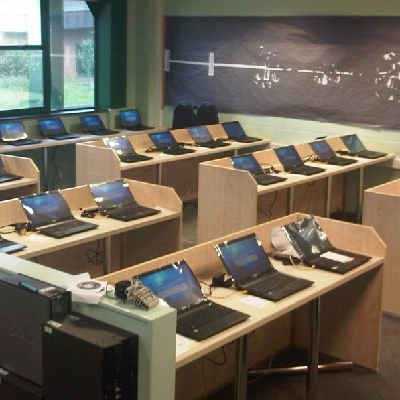
tech in schools
Small-group work springs naturally from the use of computers and video technology. Four or five kids sharing a video camera can put together a project combining several media, for example. Or simulation software can generate realistic situations on one classroom computer, with teams of students working out solutions in smaller groups.
“No amount of interactive technology can substitute for dynamic human interactivity,” warns David Dockterman of Tom Snyder Productions, who has developed a number of classroom software programs that are geared to stimulate thoughtful discussions in the one-computer classroom. “But videos and computers can often spark that by setting up learning in a rich narrative context-which is how people learn things best.”
Merely to deal with the amount of information exploding into students’ lives, Kathy Pelles observes, teaching tasks must aim to develop what School of the Future calls students’ “GUMS skills”-getting, understanding, manipulating, and synthesizing information. “We asked kids to make hypermedia stacks about whether our school rule on offensive language violated their right to free speech, for example,” she says. “It took time for them to figure out what to put into the stack, how to make comparisons and contrasts, how to present the material persuasively.”
In fact, students working with computer hypercard stacks to select and organize information are often using their minds in quite different ways from their pencil-wielding predecessors, observes humanities teacher Kathy Juarez, who teaches at Piner High School in Santa Rosa, California. “It’s important to acknowledge that technology can stretch our mental boundaries,” she says. “We now have the power to do things we haven’t even imagined before.” Piner teachers believe that students must be trained to use technological tools to negotiate their future successfully; they are discussing a new list of desired high- tech skills that dovetail nicely, they say, with their Essential School goals.
On the other side of the coin, ed.gov notes that many worry that electronic short-cuts will seduce schools into shortchanging the three R’s. But they can just as easily have the reverse effect- computer searches don’t work, after all, if you can’t spell the key words. In the high-tech library at Paul M. Hodgson Vocational-Technical High School in Newark, Delaware, for example, a frustrated senior boy combed an on-line catalog in vain for materials on “19th-centrey tools.” Principal Steven Godowsky corrected the student’s spelling, then made sure his English teacher followed up on the problem.
Teaching higher-order basics, too, becomes more important in the information age. “If ever there was a need for coaching students to use their minds well, it’s now,” says Piner’s Kathy Juarez. “It’s naive to think that even with technology kids are going to be able to make meaning of this incredible glut of information without learning to make connections between things, ask the right questions, make logical selections. But that’s not to say it’ll have to happen within the four walls of the classroom with 30 kids.” Indeed, Piner students have liberal access not only to classroom computers but to the off-line adult world outside their school, where they work with mentors on a range of professional activities.
Curriculum Changes

Access to technology can change curriculum, too, in ways that reflect the Essential School emphasis on depth in student learning and a generalist’s attitude on the part of teachers. At Catalina Foothills High School in Tucson, Arizona, science teacher Frank Draper uses sophisticated computer simulations to get students thinking about “system dynamics”-how decisions and actions affect the workings of entire systems from copper mining to flu epidemics. Working in teams at networked computer stations, students in one class compete for mining resources on an imaginary island, investigating nonrenewable resource management.
From bbc.com, “The computer tells them what kind of soil sample their team ‘discovers,”‘ Draper says. “Then they go get an actual sample from the classroom cupboards, analyze it chemically to determine its ore yield, and enter their results in. They can construct deals to trade land with other students, trying to run a profitable company while applying- and assessing-their knowledge of chemistry and economics.” After a week of such grounding, students play out a number of “what if” scenarios using computer modeling, through a simulation program called STELLA.
At Chicago’s Sullivan High School, where Socratic seminars drive the curriculum, students are using IBM’s modern version of medieval illuminated books and manuscripts; by clicking on a word in the text they can access interviews, background materials, and various other related topics. It is a small step, David Niguidula points out, to “illuminating” their own texts similarly, opening up a new realm of academic discourse. At Hope High School in Providence, Rhode Island, Kay Scheidler’s students have replaced their textbook with a Hypercard “corpus” of material about United States history and literature. Not only can students access key primary sources, but they can add to the body of knowledge by making their own work available for reference by other students.
